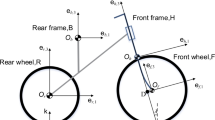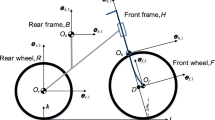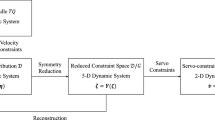Abstract
In this paper we consider the dynamics of a roller bicycle on a horizontal plane. For this bicycle we derive a nonlinear system of equations of motion in a form that allows us to take into account the symmetry of the system in a natural form. We analyze in detail the stability of straight-line motion depending on the parameters of the bicycle. We find numerical evidence that, in addition to stable straight-line motion, the roller bicycle can exhibit other, more complex, trajectories for which the bicycle does not fall.











Similar content being viewed by others
Notes
Since \({\rm Re}\lambda<0\) for stable equilibrium points, it follows that \(|({\rm Re}\lambda)_{\max}|\) is minimal.
References
Borisov, A. V., Jalnine, A. Yu., Kuznetsov, S. P., Sataev, I. R., and Sedova, J. V., Dynamical Phenomena Occurring due to Phase Volume Compression in Nonholonomic Model of the Rattleback, Regul. Chaotic Dyn., 2012, vol. 17, no. 6, pp. 512–532.
Borisov, A. V., Kilin, A. A., and Mamaev, I. S., A Parabolic Chaplygin Pendulum and a Paul Trap: Nonintegrability, Stability, and Boundedness, Regul. Chaotic Dyn., 2019, vol. 24, no. 3, pp. 329–352.
Borisov, A. V. and Mamaev, I. S., Strange Attractors in Rattleback Dynamics, Physics-Uspekhi, 2003, vol. 46, no. 4, pp. 393–403; see also: Uspekhi Fiz. Nauk, 2003, vol. 173, no. 4, pp. 407-418.
Borisov, A. V. and Mamaev, I. S., Symmetries and Reduction in Nonholonomic Mechanics, Regul. Chaotic Dyn., 2015, vol. 20, no. 5, pp. 553–604.
Borisov, A. V., Mamaev, I. S., and Bizyaev, I. A., Dynamical Systems with Non-Integrable Constraints: Vaconomic Mechanics, Sub-Riemannian Geometry, and Non-Holonomic Mechanics, Russian Math. Surveys, 2017, vol. 72, no. 5, pp. 783–840; see also: Uspekhi Mat. Nauk, 2017, vol. 72, no. 5(437), pp. 3-62.
Dikarev, E. D., Dikareva, S. B., and Fufaev, N. A., Effect of Inclination of Steering Axis and of Stagger of the Front Wheel on Stability of Motion of a Bicycle, Mech. Solids, 1981, vol. 16, no. 1, pp. 60–63; see also: Izv. Akad. Nauk SSSR. Mekh. Tverd. Tela, 1981, no. 1, pp. 69-73.
Gonchenko, S., Gonchenko, A., Kazakov, A., and Samylina, E., On Discrete Lorenz-Like Attractors, Chaos, 2021, vol. 31, no. 2, Art. 023117, 20 pp.
Gonchenko, S., Karatetskaia, E., Kazakov, A., and Kruglov, V., Conjoined Lorenz Twins: A New Pseudohyperbolic Attractor in Three-Dimensional Maps and Flows, Chaos, 2022, vol. 32, no. 12, Paper No 121107, 13 pp.
Gonchenko, S. V., Kazakov, A. O., and Turaev, D. V., Wild Pseudohyperbolic Attractor in a Four-Dimensional Lorenz System, Nonlinearity, 2021, vol. 34, no. 4, pp. 2018–2047.
Gonchenko, S. V., Ovsyannikov, I. I., Simó, C., and Turaev, D., Three-Dimensional Hénon-Like Maps and Wild Lorenz-Like Attractors, Internat. J. Bifur. Chaos Appl. Sci. Engrg., 2005, vol. 15, no. 11, pp. 3493–3508.
Gonchenko, A. S. and Samylina, E. A., On the Region of Existence of a Discrete Lorenz Attractor in the Nonholonomic Model of a Celtic Stone, Radiophys. Quantum El., 2019, vol. 62, no. 5, pp. 369–384; see also: Izv. Vyssh. Uchebn. Zaved. Radiofizika, 2019, vol. 62, no. 5, pp. 412-428.
Hamel, G., Die Lagrange-Eulerschen Gleichungen der Mechanik, Z. Math. u. Phys., 1904, vol. 50, pp. 1–57.
Hamel, G., Theoretische Mechanik: Eine einheitliche Einführung in die gesamte Mechanik, Grundlehren Math. Wiss., vol. 57, Berlin: Springer, 1978.
Hand, R. S., Comparisons and Stability Analysis of Linearized Equations of Motion for a Basic Bicycle Model, Master’s Thesis, Ithaca,N.Y., Cornell Univ., 1988, 200 pp.
Hénon, M., On the Numerical Computation of Poincaré Maps, Phys. D, 1982, vol. 5, no. 2–3, pp. 412–414.
Kazakov, A. O., Murillo, A., Vieiro, A., and Zaichikov, K., Numerical Study of Discrete Lorenz-Like Attractors, Regul. Chaotic Dyn., 2024, vol. 29, no. 1, pp. 78–99.
Kirillov, O. N., Locating the Sets of Exceptional Points in Dissipative Systems and the Self-Stability of Bicycles, Entropy (Basel), 2018, vol. 20, no. 7, pp. 502–517.
Kooijman, J. D. G., Meijaard, J. P., Papadopoulos, J. M., Ruina, A., and Schwab, A. L., A Bicycle Can Be Self-Stable without Gyroscopic or Caster Effects, Science, 2011, vol. 332, no. 6027, pp. 339–342.
Kooijman, J. D. G., Meijaard, J. P., Papadopoulos, J. M., Ruina, A., and Schwab, A. L., Supporting Online Text Material (SOM Chapters 1–11) for “A Bicycle Can Be Self-Stable without Gyroscopic or Caster Effects”, [Science, 2011, vol. 332, no. 6027, pp. 339-342], http://bicycle.tudelft.nl/stablebicycle/ (2011).
Kozlov, V. V. and Kolesnikov, N. N., On Theorems of Dynamics, J. Appl. Math. Mech., 1978, vol. 42, no. 1, pp. 26–31; see also: Prikl. Mat. Mekh., 1978, vol. 42, no. 1, pp. 28-33.
Kuptsov, P. V. and Kuznetsov, S. P., Lyapunov Analysis of Strange Pseudohyperbolic Attractors: Angles between Tangent Subspaces, Local Volume Expansion and Contraction, Regul. Chaotic Dyn., 2018, vol. 23, no. 7–8, pp. 908–932.
Kuznetsov, Yu. A., Meijer, H. G. E., and van Veen, L., The Fold-Flip Bifurcation, Internat. J. Bifur. Chaos Appl. Sci. Engrg., 2004, vol. 14, no. 7, pp. 2253–2282.
Meijaard, J. P., Papadopoulos, J. M., Ruina, A., and Schwab, A. L., Linearized Dynamics Equations for the Balance and Steer of a Bicycle: A Benchmark and Review, Proc. R. Soc. A Math. Phys. Eng. Sci., 2007, vol. 463, no. 2084, pp. 1955–1982.
Ricci, F. and Frosali, G., A Symbolic Method for the Analysis of a Nonlinear Two-Mass-Skate Model, https://arxiv.org/abs/1611.07796 (2016).
Schwab, A. L., Meijaard, J. P., and Papadopoulos, J. M., A Multibody Dynamics Benchmark on the Equations of Motion of an Uncontrolled Bicycle, in Proc. of the 5th EUROMECH Nonlinear Dynamics Conf. (ENOC’2005, Eindhoven University of Technology, The Netherlands, Aug 2005), D. H. van Campen, M. D. Lazurko, W. P. J. M. van den Oever (Eds.), Eindhoven: Eindhoven Univ. of Technology , pp. 511–521.
Shilnikov, L. P., Shilnikov, A. L., Turaev, D., and Chua, L. O., Methods of Qualitative Theory in Nonlinear Dynamics: Part 1, World Sci. Ser. Nonlinear Sci. Ser. A Monogr. Treatises, vol. 4, River Edge, N.J.: World Sci., 1998.
Shil’nikov, A. L., Shil’nikov, L. P., and Turaev, D. V., Normal Forms and Lorenz Attractors, Internat. J. Bifur. Chaos Appl. Sci. Engrg., 1993, vol. 3, no. 5, pp. 1123–1139.
Wiggins, S., Introduction to Applied Nonlinear Dynamical Systems and Chaos, 2nd ed., Texts Appl.Math., vol. 2, New York: Springer, 2003.
Xiong, J., Jia, Y.-B., and Liu, C., Symmetry and Relative Equilibria of a Bicycle System, Russian J. Nonlinear Dyn., 2021, vol. 17, no. 4, pp. 391–411.
Xiong, J., Wang, N., and Liu, C., Stability Analysis for the Whipple Bicycle Dynamics, Multibody Syst. Dyn., 2020, vol. 48, no. 3, pp. 311–335.
ACKNOWLEDGMENTS
The authors extend their gratitude to Alexey O. Kazakov for fruitful discussions.
Funding
Author information
Authors and Affiliations
Corresponding authors
Ethics declarations
The authors declare that they have no conflicts of interest.
Additional information
PUBLISHER’S NOTE
Pleiades Publishing remains neutral with regard to jurisdictional claims in published maps and institutional affiliations.
MSC2010
37J60, 34A34
APPENDIX. EXPLICIT FORM OF THE MATRIX $${\bf\tilde{I}}$$ AND OF THE VECTOR $$\boldsymbol{\Phi}$$
In order to explicitly write the terms appearing in Eqs. (2.13), we define the vectors introduced above: the normal vector and the unit vector directed along the translational velocity of the contact point of the handlebar
The components of the vector \(\boldsymbol{\Phi}\) which appears in Eqs. (2.13) have the following form:
We see that, when \(\theta=\pm\pi/2\), the components of the matrix \({\bf\tilde{I}}\) and the vector \(\boldsymbol{\Phi}\) have a singularity.
Rights and permissions
About this article
Cite this article
Bizyaev, I.A., Mamaev, I.S. Nonlinear Dynamics of a Roller Bicycle. Regul. Chaot. Dyn. (2024). https://doi.org/10.1134/S1560354724530017
Received:
Revised:
Accepted:
Published:
DOI: https://doi.org/10.1134/S1560354724530017




